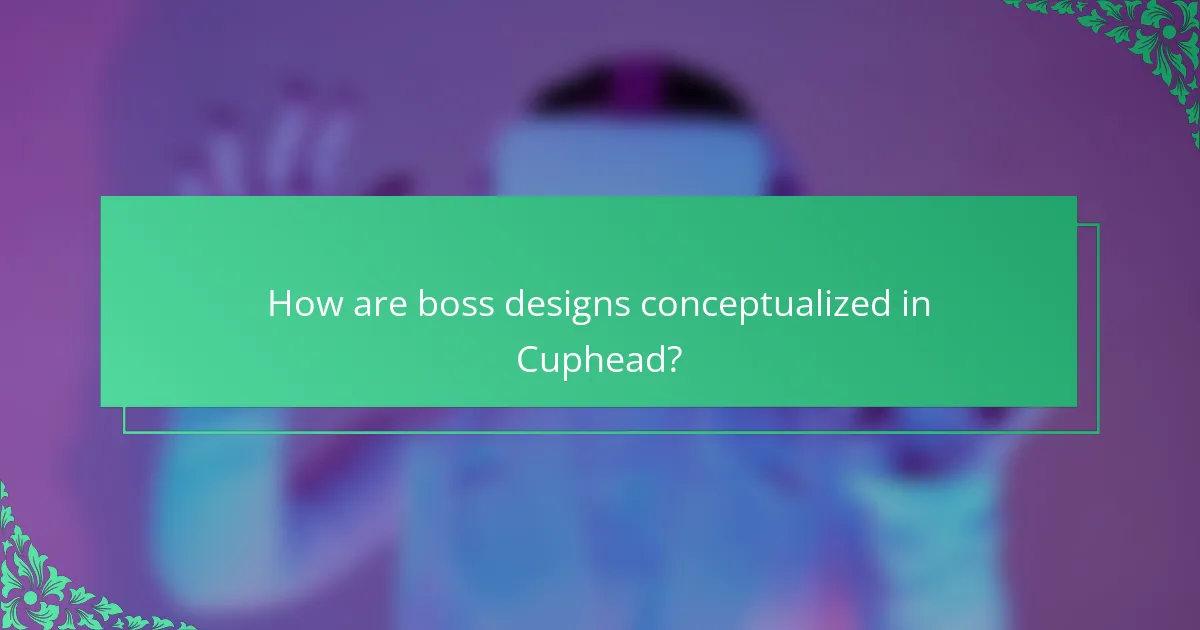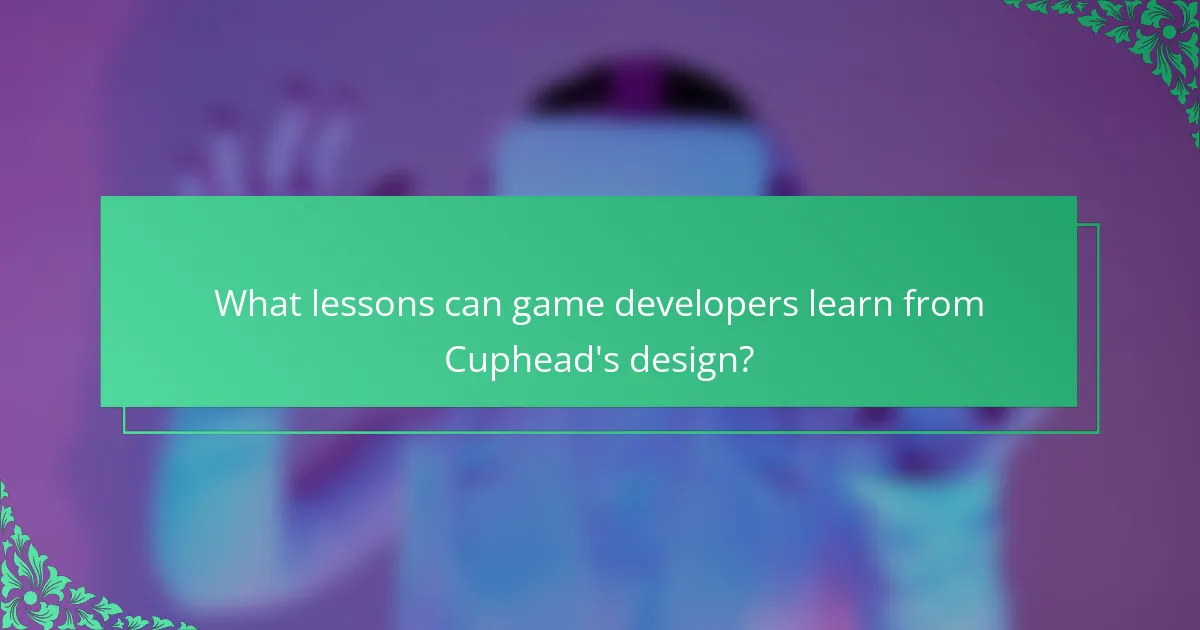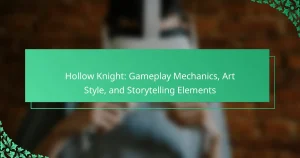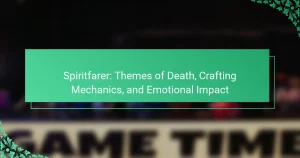Cuphead captivates players with its unique visual aesthetics, challenging difficulty levels, and imaginative boss designs. The hand-drawn art style evokes 1930s animation, enhancing player immersion. Each difficulty setting offers distinct gameplay experiences, while the creatively designed bosses present unique challenges. Together, these elements create a memorable and engaging gaming experience.

What are the visual aesthetics of Cuphead?
Cuphead features a unique visual aesthetic reminiscent of 1930s animation, characterized by hand-drawn art, vibrant colours, and fluid animations. The game employs a distinctive style known as “rubber hose” animation, which emphasises exaggerated movements and whimsical character designs. This retro aesthetic enhances the game’s charm and immerses players in a nostalgic experience. The detailed backgrounds and expressive character animations contribute to the overall artistic appeal, making Cuphead visually striking and memorable.
How does the 1930s cartoon style influence gameplay?
The 1930s cartoon style significantly influences gameplay in Cuphead by enhancing visual storytelling and challenging mechanics. This retro aesthetic creates a whimsical yet difficult environment, immersing players in a unique experience. The hand-drawn animations and vibrant colours evoke nostalgia, while the intricate boss designs require precise timing and skill. As a result, the gameplay mirrors the unpredictable nature of classic cartoons, where players must adapt quickly to survive.
Which colour palettes are commonly used in Cuphead?
Cuphead commonly uses vibrant, vintage-inspired colour palettes that evoke the 1930s animation style. The game features bold primary colours, pastel shades, and contrasting hues to create a whimsical yet challenging aesthetic. This unique visual approach enhances gameplay and character designs, contributing to its distinct charm.
What role does animation play in the overall experience?
Animation significantly enhances the overall experience in Cuphead by creating a unique visual style and engaging gameplay. The hand-drawn animation mimics 1930s cartoons, immersing players in a nostalgic atmosphere. This aesthetic not only captivates but also complements the game’s challenging difficulty levels. Each boss design showcases distinct animation techniques, adding personality and flair, which keeps players motivated despite the game’s rigorous demands. The fluidity of animation contributes to the game’s rhythm, making each encounter feel dynamic and rewarding. Overall, animation serves as a foundational element that shapes player engagement and satisfaction.
How do environmental designs enhance the narrative?
Environmental designs in Cuphead enhance the narrative by creating immersive, visually striking worlds that reflect the game’s themes. The hand-drawn aesthetics evoke a vintage cartoon style, enriching the storytelling experience. Each environment serves as a backdrop that complements character designs and gameplay mechanics, reinforcing the challenge and charm of the game. For instance, the contrasting difficulty levels are mirrored in the complexity of the environments, making each boss encounter feel unique and engaging. This synergy between visuals and gameplay deepens player immersion and emotional investment.

What makes Cuphead’s difficulty levels unique?
Cuphead’s difficulty levels stand out due to their unique blend of challenging gameplay and artistic design. The game features distinct difficulty settings that impact enemy behaviour and attack patterns. Players face relentless bosses that require precise timing and strategy, enhancing the sense of accomplishment upon victory. Each difficulty level provides a different experience, appealing to both casual and hardcore gamers. The game’s visual aesthetics complement its difficulty, immersing players in a vintage cartoon world that contrasts the intense gameplay.
How are difficulty settings structured for players?
Cuphead features a structured difficulty system designed to cater to various player skill levels. The game offers three main difficulty settings: simple, regular, and expert. Each setting alters enemy behaviour, health, and attack patterns, enhancing the challenge progressively. For example, the regular mode presents a balanced experience, while expert mode intensifies the gameplay with more aggressive enemies and intricate patterns. This tiered approach allows players to choose their preferred challenge level, promoting engagement and replayability.
What strategies can players use to overcome challenging levels?
Players can use various strategies to overcome challenging levels in Cuphead. Mastering boss patterns is crucial; each boss has unique attack sequences. Timing dodges and parries effectively can prevent damage. Utilizing power-ups strategically enhances player capabilities. Cooperative play allows for shared strategies and support. Practicing levels repeatedly builds familiarity, improving overall performance. Finally, analysing gameplay footage can reveal hidden techniques and approaches.
Which player demographics find the difficulty appealing?
Players who enjoy challenging gameplay and artistic visuals are drawn to Cuphead. This demographic includes hardcore gamers who appreciate retro aesthetics and intricate boss designs. The game’s difficulty attracts those seeking a rewarding experience, often appealing to younger audiences and nostalgic older players. Additionally, fans of platformers and indie games find the unique blend of challenges and visual style particularly engaging.

How are boss designs conceptualized in Cuphead?
Boss designs in Cuphead are conceptualized through a blend of vintage animation styles and imaginative character traits. Each boss features unique visual elements that reflect their thematic backgrounds, contributing to the game’s distinctive aesthetic. The difficulty levels are intricately tied to these designs, as each boss presents unique attack patterns and challenges that enhance gameplay. The hand-drawn art style, inspired by 1930s cartoons, further elevates the experience, making each encounter visually captivating and memorable.
What are the key characteristics of Cuphead’s bosses?
Cuphead’s bosses are characterized by their unique designs, challenging difficulty, and distinct visual aesthetics. Each boss features a hand-drawn art style inspired by 1930s cartoons. The difficulty levels vary significantly, requiring players to learn attack patterns and strategies. Boss designs often incorporate whimsical themes, such as food or folklore, contributing to their memorable presence. Additionally, each encounter offers a unique gameplay experience, emphasizing creativity and skill.
How do boss mechanics vary across different encounters?
Boss mechanics in Cuphead vary significantly across encounters, impacting gameplay experience. Each boss introduces unique attack patterns and strategies, demanding different player responses. For instance, some bosses employ rapid-fire projectiles, while others utilize environmental hazards. The visual aesthetics contribute to the thematic diversity, enhancing the challenge. Additionally, difficulty levels increase as players progress, with later bosses featuring more complex mechanics and requiring precise timing. Overall, the variety in boss designs fosters a dynamic and engaging gameplay environment.
What influences the creative process behind boss designs?
The creative process behind boss designs in Cuphead is influenced by art style, gameplay mechanics, and player experience. The game’s hand-drawn animation draws inspiration from 1930s cartoons, creating a unique visual aesthetic. This style complements the challenging difficulty levels, which are designed to enhance player engagement. Boss designs are meticulously crafted to provide distinct challenges, each with unique attack patterns and visual flair, ensuring memorable encounters. The blend of these elements fosters a cohesive experience that resonates with players seeking both nostalgia and challenge.

What impact do visual aesthetics have on player engagement?
Visual aesthetics significantly enhance player engagement in Cuphead by creating an immersive experience. The hand-drawn art style, inspired by 1930s animation, captivates players visually. This unique aesthetic fosters a strong emotional connection, encouraging prolonged gameplay. The vibrant colours and attention to detail in character designs also contribute to the game’s appeal, making each boss encounter memorable. As a result, players are more likely to invest time and effort into mastering the challenging gameplay mechanics.
How does the art style affect player immersion?
The art style significantly enhances player immersion in Cuphead by creating a nostalgic, hand-drawn aesthetic reminiscent of 1930s cartoons. This unique visual approach captivates players, drawing them into a vibrant world filled with imaginative characters and environments. The meticulous attention to detail in animations and backgrounds fosters a deeper emotional connection, making gameplay feel more engaging. Additionally, the challenging difficulty levels and creative boss designs complement the visual aesthetics, reinforcing the immersive experience through a blend of art and gameplay dynamics.
What feedback do players give regarding the visuals?
Players generally praise Cuphead’s visuals for their unique hand-drawn style and vibrant colours. Many highlight the nostalgic 1930s cartoon aesthetic, which enhances the game’s charm. The fluid animations and intricate backgrounds contribute to an immersive experience. Some feedback mentions that the high level of detail in boss designs adds to the game’s appeal, making each encounter visually distinct and memorable. Overall, the visuals are a significant factor in the game’s popularity.
How do aesthetics influence the game’s cultural perception?
Aesthetics significantly shape Cuphead’s cultural perception by blending vintage animation with challenging gameplay. The game’s unique 1930s cartoon style evokes nostalgia, attracting diverse audiences. This visual aesthetic enhances player immersion and emotional engagement, reinforcing the game’s reputation for difficulty. As a result, Cuphead is celebrated not just for its gameplay, but also for its artistic brilliance, influencing how players and critics discuss its cultural impact.

What lessons can game developers learn from Cuphead’s design?
Game developers can learn valuable lessons from Cuphead’s design, particularly in its visual aesthetics, difficulty levels, and boss designs. The hand-drawn animation style creates a unique visual identity that stands out in the gaming market. This distinctive aesthetic enhances player immersion and emotional engagement.
Cuphead’s difficulty levels are meticulously calibrated, offering a challenging yet fair experience that encourages mastery. This design approach promotes player satisfaction and a sense of achievement upon overcoming obstacles. The game features a variety of boss designs, each with unique mechanics and visual styles, keeping the gameplay fresh and engaging.
These elements combined illustrate the importance of a cohesive design philosophy that prioritises player experience, aesthetic uniqueness, and innovative challenges.
Which best practices can enhance visual storytelling in games?
Utilising distinct visual styles, engaging animations, and thematic consistency enhances storytelling in games like Cuphead. Effective use of colour palettes and character design can convey emotions and narrative depth. Integrating difficulty levels with visual cues allows players to anticipate challenges, enriching gameplay experience. Boss designs that reflect unique attributes create memorable encounters, reinforcing the game’s aesthetic and thematic elements.
What common mistakes should developers avoid when designing difficult games?
Developers should avoid common mistakes like misjudging difficulty balance, neglecting player feedback, and overcomplicating mechanics. Misjudging difficulty can frustrate players, leading to disengagement. Neglecting player feedback may result in unaddressed pain points that detract from enjoyment. Overcomplicating mechanics can confuse players, detracting from the game’s aesthetic appeal and flow.
How can developers balance aesthetics and gameplay challenges?
Developers can balance aesthetics and gameplay challenges by integrating visual design with engaging mechanics. Cuphead exemplifies this synergy through its hand-drawn animation and challenging boss designs. The unique attribute of Cuphead lies in its 1930s cartoon style, which complements the game’s difficulty levels, enhancing player immersion. Aesthetically pleasing visuals attract players, while well-crafted challenges maintain engagement. This balance ensures that players appreciate both the art and the gameplay experience.


